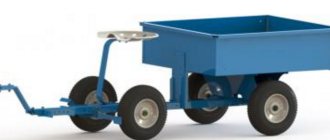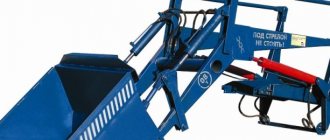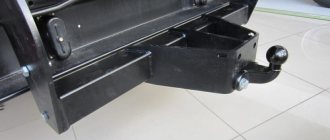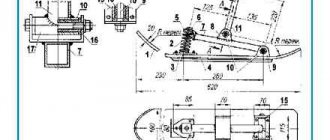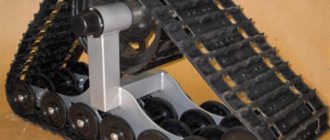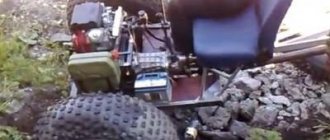When purchasing a summer house, you should prepare for constant work in the garden or vegetable garden. They can be different: from planting cultivated plants to building a small country house. But in any case, you will have to move objects from one place to another. To make it easier, use a trolley. It is very convenient to transport fertilizer, bricks, and weeds. It is especially relevant during construction work in order to easily transport materials.
Nowadays, quite a lot of options can be found in specialized stores. The price for such a product varies in the average range and depends on the main characteristics: size, main material, quality of construction. But you can try to make a cart with your own hands if you have a little experience and free time.
How to make a self-propelled cart with your own hands
When purchasing a summer house, you should prepare for constant work in the garden or vegetable garden.
They can be different: from planting cultivated plants to building a small country house. But in any case, you will have to move objects from one place to another. To make it easier, use a trolley. It is very convenient to transport fertilizer, bricks, and weeds. It is especially relevant during construction work in order to easily transport materials. Nowadays, quite a lot of options can be found in specialized stores. The price for such a product varies in the average range and depends on the main characteristics: size, main material, quality of construction. But you can try to make a cart with your own hands if you have a little experience and free time.
Why us
The following favorable delivery conditions apply to Gortorgsnab customers:
- Warehouse equipment and machinery for any task - from small warehouses in shops and supermarkets to large models with high loading capacity for large warehouses and warehouse complexes with high racks and rack structures.
- Turnkey delivery. From consultations with specialists on the selection of suitable equipment and machinery for the warehouse to delivery, installation supervision, and service.
- Favorable prices. There are inexpensive devices and cars for sale, and promotions are often held, so you can buy the models you are interested in much cheaper.
To consult with our specialists and place an order for the equipment you are interested in, call tel. 8-800-234-06-84 or leave a request on the website.
Other popular sections:
What should you pay attention to when making a homemade cart?
To make a cart yourself, you first need to decide on its main purpose and properties. For example, if a cart is intended to transport heavy objects, then it must be durable and have increased load capacity. And for transporting sand or granite, a low structure should be made, which will facilitate the process of pouring building material using a shovel. Experienced builders also recommend paying attention to certain nuances:
- maximum volume value;
- maneuverability;
- power and strength of the internal combustion engine.
Good maneuverability will allow you to easily overcome difficulties and obstacles when the cart is fully loaded. The large volume of the body will allow you to transfer a lot of material at one time, so as not to go several times. Therefore, these features must be taken into account before making the product.
Main components of the product
- Frame. It is made by welding from corrugated pipe;
- Body. Various options are possible. Made from boards or plywood mounted on steel corners. Made from steel sheets using welding. The sides can be fixed or folding;
- Hitch (drawbar). The length is selected based on the ease of control of the walk-behind tractor. It is a continuation (element) of the frame;
- Sitting. Mounted on the coupling device or in the body, in accordance with the design of the walk-behind tractor;
- Steering gear. The most complex element of the design. Must provide horizontal articulation of the drawbar with the coupling device of the walk-behind tractor. If possible, a hinge with two degrees of freedom should be provided. Otherwise, in areas with difficult terrain, additional torsional loads will arise between the frame and the walk-behind tractor;
- Suspension. It can be portal or axial, depending on the design of the wheel rims. It is possible to install elastic elements, but this complicates the design and reduces the load capacity. At low speeds and sufficient tire profile height, shock absorbers are not necessary.
If the power of the walk-behind tractor allows, you can make a four-wheeled cart. This increases stability and gives an advantage when transporting large loads.
In this embodiment, the front axle is mounted on a turntable. The joint with the walk-behind tractor can be rigid or articulated. In the first case, the force when turning increases, in the second, it is necessary to minimize the play in the hinge.
Required materials and creation process
Important! Materials should be purchased at a construction base, because the price for them in specialized stores or on the construction market is significantly inflated.
To create a cart you need to purchase:
- metal parts: pipes, slats, various plates and more;
- wooden parts: you can use those that are suitable for making a body or frame;
- wheels that are suitable for both a bicycle and a walk-behind tractor, car, scooter;
- an internal combustion engine that must have good power.
The easiest way to make a cart is to use an unwanted old motor cultivator that has broken down. First, you can try to fix it and figure out the cause of the malfunction. A repaired engine will make working moments easier in the future. After this, you should begin making a frame on which to attach the internal combustion engine and the body of the trolley. It is best to take iron corners, because they are quite durable and have high performance characteristics if they are consistently looked after and treated with a special product.
Many experts recommend first making a drawing of the frame, and only then starting work.
Assembling a homemade trailer for a walk-behind tractor
When starting to implement a project, a DIYer needs:
- create a working draft or drawing (drawing);
- prepare material for the frame and other main components;
- prepare the workplace;
- mark the main structural elements of the trailer;
- lay out and adjust alignment angles;
- collect part templates;
- carry out the adjustment of the purchased entire units to the structural elements.
Required tools and materials
To carry out the work, you need to prepare all the necessary tools:
- welding machine;
- grinder with a set of cutting and abrasive discs;
- measuring instrument - tape measure, metal ruler, protractor, square, marker and chalk, metal scriber;
- hammer, chisel, pliers;
- bench vice, set of clamps, welding clamps;
- drill, set of metal drills;
- riveter
The required materials will be:
- steel square or rectangular pipe 60×60 or 60×30 mm;
- steel square pipe 30×30 or 25×25 mm;
- corner 25×25 mm;
- channel;
- springs of the Moskvich passenger car;
- steel sheet 2 mm thick;
- galvanized sheet 1 or 0.8 mm thick;
- fasteners, bolts, nuts, rivets.
For a rigid body model, instead of a spring-loaded wheel set on springs, you will need a regular beam.
The wheels need to be selected immediately with the hubs, this will facilitate further assembly of the homemade product.
Frame
The trailer frame is an all-welded structure in the form of a frame lattice made of a square pipe. Traverses made from a 25×25 mm square form the cross members of the frame, and the spars are made from a 60×60 or 60×30 mm pipe. After marking, all structural elements are cut and laid out on a flat surface, the joints are welded with small seams, and each joint of the elements is checked with a square. After assembling the structure, final welding of all parts is carried out along the perimeter of all planes. The frame is painted after treating the surface with a metal primer.
Chassis
The basis of the chassis is a beam with hubs at the ends. The channels are joined to each other in such a way that they form a square. The joints are welded with a continuous seam. Wheel hubs are installed at the ends of the axle and welded.
The accuracy of the axle assembly is checked by checking the parallelism of the planes of the wheel rims. The connection between the frame and the beam is carried out using springs, while the ends of the springs are installed in welded brackets on the frame, and the beam is pressed against the central part of the springs using an earring.
The chassis installed on the frame is additionally checked for resistance to overturning. As in a car, the axle spring group must have rubber bushings in the frame mounting bracket.
Body, frame trim
The platform is marked relative to the grid in such a way that allowances are left for attaching the side posts. The front and side boards are firmly installed, and the rear board is made removable on door hinges.
The sides of the trailer have a frame structure made of 25x25 mm corners. The corners are butt welded, the seams on the inside are cleaned to the level of the metal plane.
Removable sides are assembled in the following sequence:
- side frame;
- The galvanized iron sheet is adjusted to the size of the frame;
- The side panels are cut out and secured with rivets through the corner.
The bottom of the body, made of a 2-mm iron sheet, is installed on the frame and welded with a small seam around the perimeter every 3-5 cm.
The installation of the boards begins with the installation of the front board, then the side boards are installed and connected with a welding joint.
The tailgate is secured last - first the hinges are marked and welded, and then the latches.
Other design details
After assembling the frame and body, a folding seat is installed - a wooden bench placed on top of the front side with support on the sides.
As a trailer brake system, it is recommended to use elements of the brake system of a car whose hub and wheels are used in the design. To ensure reliable operation of the brake system, it is recommended to provide an additional lever lock.
DIY garden cart with motor
I once saw an advertisement in the regional newspaper that, as part of the interregional agricultural Belo-Bychkovo fair, a competition would be held for the best garden cart. I love making things with my hands, so why not get involved? And make not just a cart, but a self-propelled one with a motor! I had a wheelbarrow on my farm - it was left over from when I was building a garage, so we’ll take it as the basis for the design. In general, when there were two days left before the competition, work began to boil!
I started with “excavations” in the garage and pulled out a motor from the “bins” - Chinese, of course, from a gas mower or something similar, probably. With a centrifugal clutch and a power of 6.5 hp, as stated on the label. I can’t remember now what equipment it was purchased for and where I managed to work - so many different “devices” passed through my hands! Nevertheless, the “engine” turned out to be working and pleased with its compactness - just what you need for a garden cart. Suitable wheels were also found, size 3.00-4 (260×85). All that was left to do was to combine it all into a single whole, and I began to figure out the layout.
I put the engine on the floor, outlined at what distance the wheels should be made so that it would be comfortable to stand on, and the cart would not be too wide. I sketched out on paper a sketch of the future design with the main dimensions. And then he sat down at the computer and made drawings, with which he went to his workshop. I found a 20x20 mm steel profile in the blanks, cut pieces of the required length and welded the main frame. Now you need to attach the wheel axle to it. As such, I used the most ordinary water pipe with a diameter of 27 mm. What bearings should I use? There was nothing to choose from, so I decided to use plain bearings, machined from a polypropylene pipe. The inner diameter of the bushings corresponds to the thickness of the wheel axle, and the outer diameter is 42 mm - the inner diameter of the sections of steel pipe that I welded from below along the edges of the frame. The length of these clips is 50 mm, and the length of polypropylene bushings is 80 mm.
Methods for increasing cross-country ability
It should be noted that the manufacturer produced only wheeled versions of the carts. However, to increase the maneuverability of this device, various devices are used, including the use of caterpillar tracks.
Craftsmen simply take a rubber band with a length that allows them to completely cover all three wheels in a circle. On the inside of the tape, metal strips with bends are attached to it. These bends form a guide for the belt, which prevents it from being removed from the wheels.
On the outside, metal strips are also attached, which act as lugs. The wheels of the trolley are both driving and supporting for the belt. In general, it is not so difficult to make a tracked one from a wheeled unit, but while gaining in cross-country ability, the TS-350 loses speed indicators, which are not so high.
Homemade wheelbarrows: we mechanize manual labor. Part two
How to make a construction wheelbarrow with your own hands, a collection of ideas: complicated designs
In the first part of the article we looked at the following structures:
- a homemade garden wheelbarrow with a helicopter wheel;
- construction wheelbarrow from scrap metal;
- drawings of a homemade construction wheelbarrow.
In this sequel, the wheelbarrows evolve into construction carts and trailers, with the ability to not only turn, but also tilt the body. And also, we learn about the car, the existence of which the hero of the famous joke did not believe —
with a motor.
Construction wheelbarrow made of wood, like a bicycle trailer
Wheelbarrows for construction are made of metal. When making them, you cannot do without a welding inverter, an angle grinder and a drill. What to do if you don’t have a welder? Make a cart for transporting goods from wood.
I made a cart out of wood. I put it on two bicycle wheels. This is the second car. The first design was not very successful, as the wheels were too close to each other.
The evolution of the wooden cart. The user attached a long handle to the wheelbarrow. The wheels were set wider.
Wooden wheels for a garden wheelbarrow
Practice shows that wheels are traditionally the weakest link of any construction vehicle. They cannot withstand heavy loads. Tires puncture, crack, slip off the wheel rim, etc. A radical solution to the problem is proposed by a portal member with the nickname MrGinaki. He made “indestructible” wooden wheels for the wheelbarrow.
The width of the car body is 650 mm. Length – 900 mm.
How to make homemade wheels for a wheelbarrow is clearly shown in the photo instructions.
The finished wheel has a diameter of 35 cm.
MrGinaki
I carried 6 bags of cement, 50 kg each, in a wheelbarrow. I also use it as a bucket for mixing cement.
What to pay attention to when making?
To make a self-propelled garden cart with your own hands, you first need to decide on the characteristics of the future product, as well as the function that your invention will perform. For example, if you need a cart to transport heavy construction materials from place to place, then it must have good load capacity. And to transport sand or gravel, you should make a low unit so that it is convenient to pour building material into it with a shovel. We also strongly recommend that you pay attention to the following nuances during construction:
- maximum volume;
- maneuverability;
- engine power.
Types of trailers
There are many different options for assembling trailers, so the first step is to decide for yourself which one is best for you. To make an informed, competent choice, you need to consider all the advantages and disadvantages of designs.
Completely solid structures are reliable, they can carry heavy loads, nothing will fall off, since all the walls are firmly welded to the base. The trolley is ideal for transport.
Transformers increase in size, as the sides can be folded back. The most convenient option is a dump truck. The body rises to a convenient height, and all the debris spills out.
Creating Drawings
Any work on making something with your own hands should begin with drawing up competent drawings, especially if we are talking about a self-propelled cart. Without a schematic drawing in front of your eyes, it will be quite easy to make a mistake in the calculations, so don’t be lazy to spend a few hours so that you don’t have to redo all the work later.
It is worth noting that the drawing must be presented in two versions. The first one should show the body and frame, which will be made from scrap materials. The second page of the drawing should be occupied by the internal combustion engine that will be used during assembly, as well as options for attaching it to the body and wheels.
Types of technology
The Tyumen plant did not spoil customers with a variety of models, but home craftsmen themselves found ways to improve their favorite equipment. Main methods:
- replacing the motor with a more powerful and less noisy one;
- equipping wheels with snow chains;
- installation of caterpillar tracks.
Making a TC 350 on tracks is very simple. There is no need to make any changes to the chassis design. Simply use a rubber band long enough to wrap around all three wheels. Metal strips are attached to the inside of the tape for a more reliable fixation on the wheels. Metal strips are also needed on the outside to provide traction to the ground. If done correctly, the belt will be held and driven by the wheels. This will greatly increase the trolley's off-road capability, but it should be taken into account that the tracked TS-350 will noticeably lose speed.
In general, cargo trolleys are divided into several types:
- self-propelled;
- manual.
Self-propelled models are equipped with an engine, manual ones, respectively, are driven by human muscular power (they are pushed in front of you or driven behind).
Self-propelled models are divided into:
- platform;
- fork;
- crane
Platform models are the best option for moving goods without pallets. They are versatile and convenient, suitable for bulk cargo. They differ in wheel sizes, dimensions and other parameters. Can be equipped with sides. TS-350 belongs to the on-board platform trolleys, and also has a platform tilt function (like a dump truck).
The surface of the loading platform may be different:
- solid smooth (made of plywood, rubber or metal);
- lattice (made from thin pipes with a round or square cross-section).
Additionally, a hydraulic lift can be installed on the platform trolley. Forklift and crane types of equipment are used to transport goods packed on pallets or long loads.
Self-propelled trolleys are also equipped with different engines:
- gasoline;
- diesel;
- electric.
An electric self-propelled trolley is indispensable in closed spaces where harmful exhaust emissions cannot be allowed. However, it loses in power to gasoline and diesel models. In particular, this is why the method of installing electric motors on the TS-350 has not caught on: it is not only not rational, but also adds hassle to constant charging in rural areas.
In general, this type of equipment is characterized by a simple and reliable design, as well as a long service life. A used self-propelled trolley is not much inferior to a new one, which expands the possibilities of completing a vehicle fleet even for novice entrepreneurs.
List of required materials
Have you decided to make an electric self-propelled cart yourself? We strongly recommend that you make a list of the necessary materials in advance and purchase them at the construction site, since in stores or on the market the price is usually several times higher. Here are just the basics that you may need:
- metal parts - pipes, plates, slats, sheets and so on;
- wooden parts - suitable for making a body and frame;
- wheels from a walk-behind tractor, bicycle, car or scooter;
- internal combustion engine with good power.
Also, one should not forget about the various fasteners, which will be different in each case. For example, if you decide to use boards for construction, you will have to acquire several dozen self-tapping screws, and for attaching metal parts it is best to use welding.
Cost of TS-350
The TS-350 self-propelled trolley was produced in the city of Tyumen. It first appeared on the market of special equipment in the mid-nineties of the last century.
Unfortunately, despite its undoubted advantages and the fact that this vehicle has proven itself well, the TS-350 trolley is no longer produced. It is possible that components for it are being produced and sold, but the author is not aware of this.
Today you can only buy a TS-350 that has been used or has been in stock. There is no single price for this vehicle. You can buy it for 5,000 rubles. You can purchase it for a price exceeding one hundred thousand rubles. In the city of Lipetsk, for example, a TS-350 is sold for 110,000 rubles. In the whole country, the price range for the TS-350 is from 25 to 50 thousand rubles.
List of required tools
In order not to be distracted by searching for the necessary tools while working, it is recommended to acquire everything you need in advance. If something is missing, then you can use an alternative option (instead of a screwdriver with self-tapping screws - a hammer and nails), but this must be done wisely so that the quality of the product does not suffer. Here is a list of the main tools you will need:
- electric jigsaw and circular saw - for wood processing;
- grinder with discs and welding machine - for working with metal;
- a screwdriver or drill with a special attachment - for fastening wood;
- a set of wrenches and screwdrivers - to remove unnecessary elements from the internal combustion engine.
Do not forget that this is only a minimal list of what may be useful in the process. It can be expanded if necessary. It all depends on what kind of cart you want to make.
Advantages and disadvantages
The main advantages of the TS 350:
- Universal. You can install additional equipment, which allows you to use it in many industries;
- Maneuverable;
- Passable;
- Can be used all year round;
- Simple controls.
Also interesting: Winch for a field in Balashikha: 500 items: free shipping, 28% discount [go]
Disadvantages: The main disadvantage is the vulnerability of the chains through which the wheels are driven. But this is easily fixed.
Metal body and internal combustion engine from a moped
In this and subsequent sections you will find information about the features of assembling garden carts with your own hands. The options can be very different. For example, you can use the internal combustion engine from a regular eighty cc moped, and also its rear wheel. In this case, there is practically no need to remove any elements. It will only be necessary to correctly attach the internal combustion engine to the metal body, the manufacture of which should also not pose any particular difficulties. You can also use the brake system from a scooter as an additional element by attaching cables from the pads to the handles.
Main stages of work
At the next stage, we cut off a small piece of the construction angle and drill mounting holes in it. Then we attach it to the gear motor housing.
After this, we install the previously removed wheel back onto the cart, having first put the chain on the sprocket. We mark and drill holes in the trough for mounting the gear motor.
The author uses a battery from a screwdriver as a power source for the electric motor. We connect the battery to the gear motor and place it in a bag, which we attach to one of the trolley handles.
You can watch the video on our website for details on how to make an electric drive for a garden cart with your own hands from a windshield wiper gear motor.
Rate this post
[Votes: 4 Average rating: 5]
Self-propelled trolley from an old tractor
If you have an old unwanted tractor that is still running, then making a self-propelled cart from it will not be difficult. We simply remove unnecessary elements from agricultural machinery, for example, the driver’s seat, and replace it with some kind of deep bathtub or body made of wood. Such a unit is ideal for transporting heavy building materials (cement, bricks, etc.) over a fairly long distance. As an additional element, we recommend making a small metal plane on which the driver can stand with his feet.
Design and features of the TS-350. Optional equipment
TS-350 has high maneuverability.
The cart's dimensions are small, so it can turn around almost in one place. In addition, the trolley has an independent transmission, which made it possible to install a separate drive for each wheel. Driving this vehicle is so easy that no special driving skills are required.
On the product site there are:
- engine;
- two gearboxes, right and left;
- control levers;
- tipping body;
- swivel seat;
- toolbox;
The cart can move both forward and backward.
The trolley has four forward speeds:
- first speed – 2 kilometers per hour;
- second speed – 4 km per hour;
- third and fourth – 6 and 12 km per hour, respectively;
The cart has two reverse speeds:
- first – 4 km per hour;
- second – 8 km per hour;
The TS-350 trolley is considered a universal device, that is, it can be converted into various units.
For this purpose, it is equipped with special attachments that are installed at the front and rear. With the help of these attachments, additional equipment is installed on the trolley. If the TS-350 is used on a farm, then a plow or harrow can be mounted on it. You can install a cultivator or a hay mower. You can use it as a water or liquid fertilizer sprayer. You can also put a water pump on the cart.
At a construction site, the trolley can be used as a concrete mixer by installing this unit on the site using a hitch. The concrete mixer is powered by the trolley engine. The cart can also be used as a miniature bulldozer. To do this, a bulldozer device with a blade is installed on it.
To transport goods, a trailer is installed in addition to the main body. It is useful in any household, including warehouses. This self-propelled cart is also used as a lift.
Of the shortcomings, only one can be noted - motorcycle chains pass under the platform. They break often and easily. But replacing the chains is not difficult, so repairing the cart does not become a problem.
Although the TS-350 is considered a mini-tractor, you do not need to obtain a license to drive this vehicle.
Drawing of a self-propelled trolley TS-350:
Take a look at the self-propelled trolley SMZh-151, an alternative to the current model.
Unit from a motor cultivator
Any motor cultivator that has failed can be used to create a self-propelled cart with your own hands. In this case, you will first have to figure out the engine problems (replace the belt or install new spark plugs), and then begin manufacturing the frame on which the internal combustion engine and the cart body will be attached. It is best to use iron corners for this purpose, welding them into a rectangle of the desired shape according to pre-prepared drawings. Then the structure will be more durable, and the self-propelled vehicle will be more reliable.
Bicycle cart - fact or fiction?
Have you decided to make a self-propelled cart from a bicycle with your own hands? You can find many instructions on the Internet on how to do this, but few people mention the capabilities of such a device. Just think, if you use thin bicycle wheels to transport a heavy load, sooner or later they will simply bend, since several bags of cement are usually several times the weight of a person. However, it would also be wrong to completely dismiss this option. This cart is perfect for summer residents who do not like to carry substrate and fertilizers for plants in buckets, but prefer to use a self-propelled device for this.

